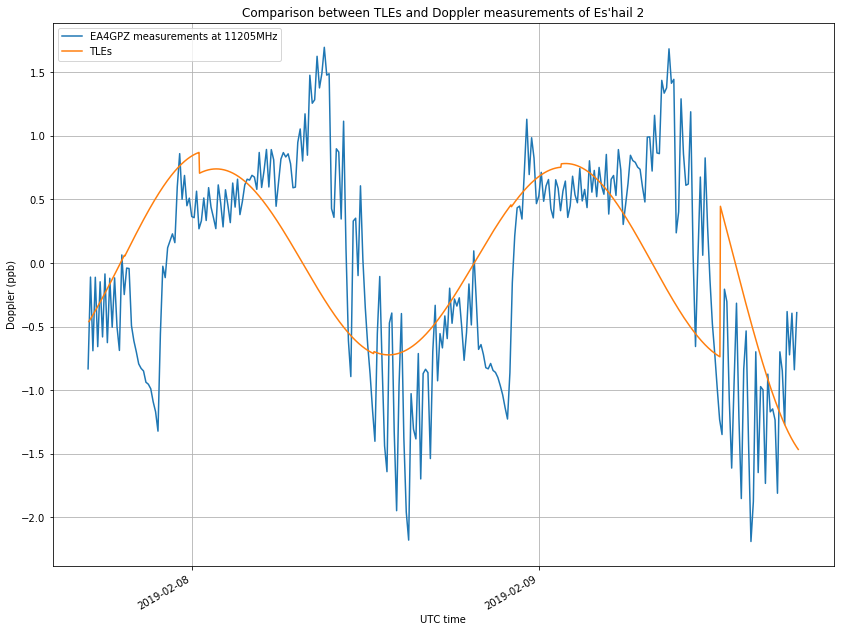After being busy with other projects, I have resumed my frequency measurements of the Es’hail 2 beacons. The last measurement I performed was made when the satellite reached its operational slot at 26ºE. After manoeuvering to this spot, the Doppler was very small, on the order of 0.8ppb peak-to-peak, indicating a very accurate geostationary orbit. Now Es’hail 2 has been two months in its operational slot, inaugurating its Amateur transponders on February 14 and entering commercial service on March 7.
I am curious about studying again the Doppler at this point in the mission, to see how accurate the GEO orbit is. I am also interested in collaborating with other Amateurs to perform differential Doppler measurements, as I did with Jean Marc Momple 3B8DU. Here I detail the first results of my measurements.
The first test I’ve done has been with the 10706MHz engineering beacon, which was the beacon on which all the previous measurements were performed. The frequency was measured over a period of three days. The raw measurements can be seen in the figure below.

We see the typical daily Doppler pattern, with an amplitude of almost 3ppb peak-to-peak. This is interesting in view of the much smaller Doppler just after Es’hail 2 reached the operational slot. The GEO orbit is now much less accurate. For comparison, the Doppler in the test slot at 24ºE was on the order of 3 or 4ppb peak-to-peak.
Another interesting thing is that the frequency is now 24ppb below nominal. During the test phase, I measured a slow steady increase in frequency, probably due to oscillator aging. The frequency was at -35ppb near the end of November, and rose to -25ppb by the end of December. Now it seems that this aging has stopped (or has been reduced a lot), and the frequency has probably stabilized around -24ppb. See this post for the long term measurements during the test phase.
The averaged Doppler (in windows of 10 minutes) compared to the Doppler predicted by TLEs is shown below. We see that the accuracy of these TLEs is not very good, as the Doppler curve doesn’t match my measurements very well.

Unfortunately, the 10706MHz beacon is now being transmitted in a regional beam, probably covering only the MENA region. It seems that Spain is one of the few places in Europe were it can be received. I have reports that it cannot be heard in the Netherlands nor in Mauritius. Therefore, my second test has been done with the 11205MHz engineering beacon, hoping that this is on a global beam and can be received by more stations (though I don’t have a good confirmation of the coverage of this beacon yet).
I have measured the 11205MHz beacon over the course of two days. The raw measurements are shown in the figure below.

The results are rather unexpected. I expected to see a more or less regular sinusoidal curve, as in the 10706MHz measurements. Instead, I have something that looks rather noisy and jumpy. I am not completely sure if this is a problem with my measurement setup, but it is identical to the setup used for 10706MHz (even the LO frequency of the LNB is the same in both tests), so I suspect that these frequency variations are really present in the signal.
The figure below shows the measurements averaged in 10 minute windows, compared to the TLEs. It seems that the measurements follow roughly the Doppler pattern predicted by the TLEs, but the jumps in frequency are evident. I don’t know the reason for the behaviour of this beacon. Stefan DK3SB suggests that maybe this beacon is frequency locked to an uplink signal.

My plan now is to try to use the 400baud BPSK beacon of the narrow band Amateur transponder for Doppler measurement. This has the advantage that it is on a global beam and many Amateurs around the world are already receiving it (in fact there are several WebSDRs for the narrow band transponder). An inconvenient is the fact that the beacon is not generated in the satellite, but rather uplinked from Doha through the transponder. Therefore, the measurements will be affected by the uplink Doppler between Doha and the satellite, and also by the frequency stability of the groundstation at Doha. Fortunately, these effects cancel out when doing differential Doppler measurements between two stations. Another disadvantage is that this beacon is BPSK rather than an unmodulated carrier, so a Costas loop must be used to measure frequency.
I will make a GNU Radio flowgraph that measures the frequency of the beacon. This will be used to assess the frequency stability of the transmitter at Doha, and as a starting point for performing differential Doppler measurements of this beacon between different Amateur stations.
The Jupyter notebook and data files used in this post can be found here.
One comment